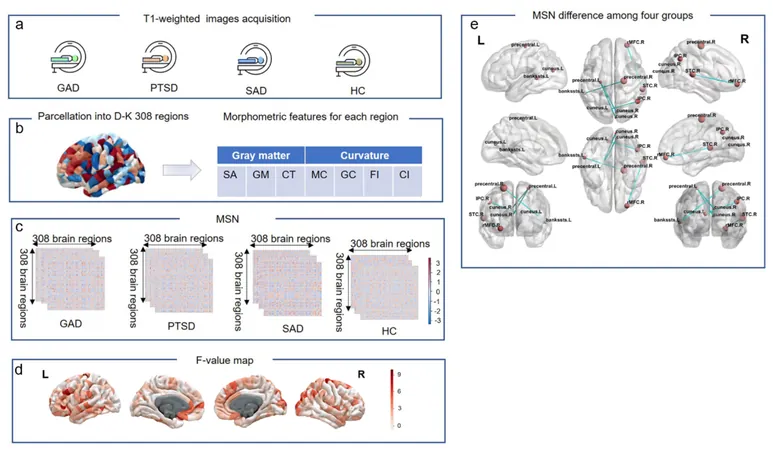
Unveiling Brain Structure Changes: Shared and Unique Features of Anxiety Disorders
2025-01-03
Author: Arjun
Unveiling Brain Structure Changes: Shared and Unique Features of Anxiety Disorders
In recent research, three prevalent anxiety disorders—Generalized Anxiety Disorder (GAD), Post-Traumatic Stress Disorder (PTSD), and Social Anxiety Disorder (SAD)—have been examined for common and unique characteristics that affect patients on both clinical and neurobiological levels. These disorders present a complex interplay, frequently co-occurring in individuals who have faced traumatic experiences, which not only complicates their diagnosis and treatment but also elevates the risk of suicidality among affected individuals.
Epidemiologically, GAD, PTSD, and SAD pose significant burdens on healthcare systems due to their high prevalence in various populations. Symptoms overlap among these disorders, including excessive fear, anxiety, and avoidance behaviors. For example, while PTSD is uniquely associated with symptoms such as dissociation and intrusive thoughts, both it and SAD show notable similarities in the fear of social judgment.
At the neurobiological level, these disorders share complex hereditary predispositions linked to several systems, notably the gamma-aminobutyric acid (GABA) system, monoamine systems, and the hypothalamic-pituitary-adrenal (HPA) axis, which are crucial for stress response regulation. Magnetic resonance imaging (MRI) studies have indicated shared structural brain changes in crucial regions related to perception and emotion, such as the amygdala and various parts of the prefrontal cortex.
One of the recently utilized methods, the Morphometric Similarity Network (MSN) analysis, allows researchers to investigate communication between brain regions on an individual basis. This method overcomes the limitations of traditional approaches by analyzing multiple morphological features simultaneously, thereby offering a nuanced view of brain architecture and its alterations due to anxiety disorders.
In a study involving 185 participants, including patients diagnosed with GAD, PTSD, and SAD, significant structural connectome abnormalities were revealed. These abnormalities were characterized by differences in gray matter properties reflecting the severity of PTSD symptoms. The study highlighted the significance of specific cortical areas, such as the anterior temporal lobe and visual cortex, that displayed varied connectivity patterns among different disorders.
Crucially, the findings indicated that both GAD and PTSD shared certain structural brain connectivity characteristics while also exhibiting unique alterations specific to each disorder. For instance, SAD manifested distinct increased morphometric similarity between visual processing centers, emphasizing its unique neurobiological profile.
The overarching implications of this research underscore the necessity for refined diagnostic and therapeutic strategies tailored to the unique yet shared features of these anxiety disorders. As marketplace innovations continue to evolve in mental health treatment, understanding the intricate neural underpinnings of anxiety disorders can lead to more targeted intervention approaches, ultimately improving patient outcomes.
In conclusion, the interplay between shared and distinct morphometric abnormalities unveils the complex neurobiological landscape of anxiety disorders, paving the way for advancements in therapeutic methodologies and a deeper understanding of mental health impacts. As research continues to unfold, it is paramount to explore these nuances to appropriately address the needs of patients grappling with these debilitating conditions.
Stay tuned for groundbreaking insights into anxiety disorders that could transform mental health care!
 Brasil (PT)
Brasil (PT)
 Canada (EN)
Canada (EN)
 Chile (ES)
Chile (ES)
 Česko (CS)
Česko (CS)
 대한민국 (KO)
대한민국 (KO)
 España (ES)
España (ES)
 France (FR)
France (FR)
 Hong Kong (EN)
Hong Kong (EN)
 Italia (IT)
Italia (IT)
 日本 (JA)
日本 (JA)
 Magyarország (HU)
Magyarország (HU)
 Norge (NO)
Norge (NO)
 Polska (PL)
Polska (PL)
 Schweiz (DE)
Schweiz (DE)
 Singapore (EN)
Singapore (EN)
 Sverige (SV)
Sverige (SV)
 Suomi (FI)
Suomi (FI)
 Türkiye (TR)
Türkiye (TR)
 الإمارات العربية المتحدة (AR)
الإمارات العربية المتحدة (AR)